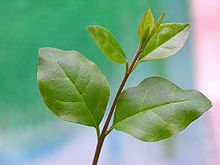| Revision as of 21:50, 10 February 2014 edit199.241.253.146 (talk) →Cultivation and uses← Previous edit | Revision as of 21:52, 10 February 2014 edit undo199.241.253.146 (talk) →Cultivation and usesNext edit → | ||
| Line 34: | Line 34: | ||
| It has also been used as a popular bonsai tree. | It has also been used as a popular bonsai tree. | ||
| It was introduced to ] to be used for hedges and landscaping where it has now escaped from cultivation and is listed as an ] in |
It was introduced to ] to be used for hedges and landscaping where it has now escaped from cultivation and is listed as an ] in southeastern states.<ref name=usda>USDA Plants Profile: </ref><ref>{{cite book |url=http://www.nps.gov/plants/alien/pubs/midatlantic/midatlantic.pdf | title=Plant Invaders of Mid-Atlantic Natural Areas, 4th Edition |last1=Swearingen |first1=Jil |last2=Reshetiloff |first2=K. |last3=Slattery |first3=B |last4=Zwicker |first4=S. | year=2010 |publisher=National Park Service and U.S. Fish & Wildlife Service |page=71}} This reference lists ''L. vulgare'', ''L. obtusifolium'', ''L. ovalifolium'', and ''L. sinense'' as invasive.</ref> It is estimated that Chinese privet now occupies over one million hectares of land across 12 states ranging from Virginia to Florida and as far west as Texas.<ref name=hanula>Hanula, J.L, Horn, S., Taylor, J.W. (2009). Chinese Privet (Ligustrum sinense) Removal and its Effect on Native Plant Communities of Riparian Forests. Invasive Plant Science and Management 2:292-300.</ref> <br clear=left> | ||
| ==References== | ==References== | ||
Revision as of 21:52, 10 February 2014
| Ligustrum sinense | |
|---|---|

| |
| Scientific classification | |
| Kingdom: | Plantae |
| (unranked): | Angiosperms |
| (unranked): | Eudicots |
| (unranked): | Asterids |
| Order: | Lamiales |
| Family: | Oleaceae |
| Tribe: | Oleeae |
| Genus: | Ligustrum |
| Species: | L. sinense |
| Binomial name | |
| Ligustrum sinense Lour. | |
Ligustrum sinense (Chinese Privet; syn. L. villosum), in Mandarin; 杻 (pinyin: chǒu) is a species of privet, native to China, Taiwan and Vietnam.
It is an deciduous shrub growing to 2–7 m tall, with densely hairy shoots. The leaves are opposite, 2–7 cm long and 1–3 cm broad, rarely larger, with an entire margin and a 2–8 mm petiole. The flowers are white, with a four-lobed corolla 3.5–5.5 mm long. The fruit is subglobose, 5–8 mm diameter.
The following varieties are accepted by the Flora of China:
- Ligustrum sinense var. sinense
- Ligustrum sinense var. concavum M.C.Chang
- Ligustrum sinense var. coryanum (W.W.Smith) Handel-Mazzetti
- Ligustrum sinense var. dissimile S.J.Hao
- Ligustrum sinense var. luodianense M.C.Chang
- Ligustrum sinense var. myrianthum (Diels) Hoefker
- Ligustrum sinense var. opienense Y.C.Yang
- Ligustrum sinense var. rugosulum (W.W.Smith) M.C.Chang
Cultivation and uses

It is cultivated as an ornamental plant and for hedges. Several cultivars have been selected, including the very floriferous 'Multiflorum', the variegated cultivar 'Variegatum', and the dwarf cultivar 'Wimbei' growing to 0.5 m and with leaves only 6 mm long.
It has also been used as a popular bonsai tree.
It was introduced to North America to be used for hedges and landscaping where it has now escaped from cultivation and is listed as an invasive plant in southeastern states. It is estimated that Chinese privet now occupies over one million hectares of land across 12 states ranging from Virginia to Florida and as far west as Texas.
References
- ^ Flora of China: Ligustrum sinense
- Huxley, A., ed. (1992). New RHS Dictionary of Gardening. Macmillan ISBN 0-333-47494-5.
- USDA Plants Profile: Ligustrum sinense
- Swearingen, Jil; Reshetiloff, K.; Slattery, B; Zwicker, S. (2010). Plant Invaders of Mid-Atlantic Natural Areas, 4th Edition (PDF). National Park Service and U.S. Fish & Wildlife Service. p. 71. This reference lists L. vulgare, L. obtusifolium, L. ovalifolium, and L. sinense as invasive.
- Hanula, J.L, Horn, S., Taylor, J.W. (2009). Chinese Privet (Ligustrum sinense) Removal and its Effect on Native Plant Communities of Riparian Forests. Invasive Plant Science and Management 2:292-300.